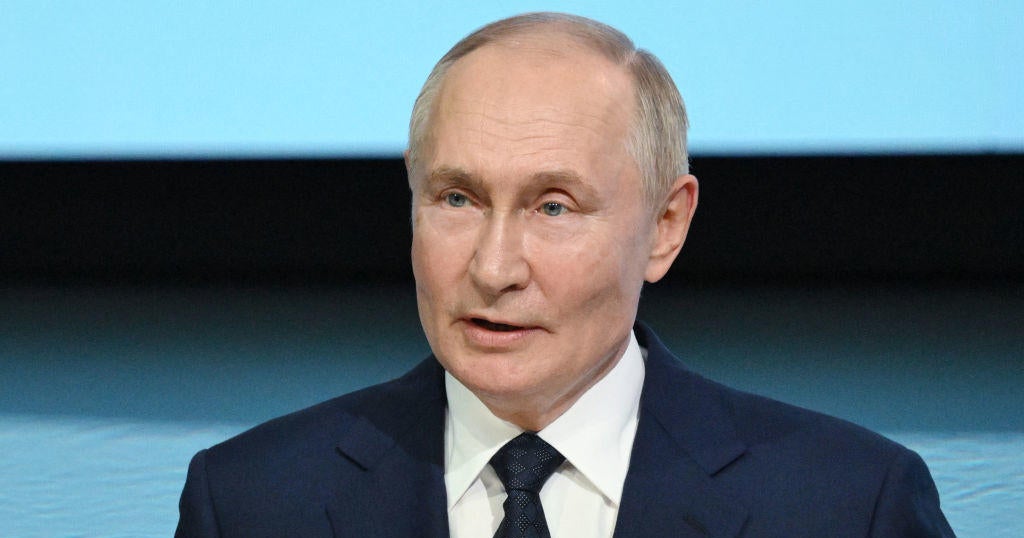U.N. nuclear chief visits Ukraine nuke plant after dam explosion, to "help prevent a nuclear accident"
United Nations — The head of the United Nations' nuclear watchdog agency made his third trip to Ukraine's Zaporizhzhia Nuclear Power Plant, Europe's largest atomic power station, this week in a bid to "prevent a nuclear accident." Ukraine accused Russia of blowing up the Kakhovka Dam, which Russian forces had occupied for months, a week and a half ago, threatening the vital cooling water supply to the sprawling nuclear plant.
The explosion at the dam sent water gushing out of the reservoir, flooding a wide region along the Dnieper River and cutting off the primary supply that fills a cooling pond at the Zaporizhzhia plant.
Russia accused Ukrainian forces of attacking the dam, but military analysts cast doubt on the claims as flooding the river valley stood to benefit Russia's forces as they try to repel a Ukrainian counteroffensive at various points along the 600-mile front line. Ukraine's president said it was "impossible" to have caused the damage done to the Russian-occupied dam with artillery, and said it was blown up "from inside."
Fighting has intensified around the Zaporizhzhia plant, which is also occupied by Russian forces, in recent months, with shelling knocking out the electricity supply to the facility seven times already, forcing it to rely on emergency diesel generators as Ukraine's infrastructure comes under increasing attack by Russian artillery.
International Atomic Energy Agency (IAEA) Director General Rafael Mariano Grossi completed his latest visit to Zaporizhzhia Thursday and was expected to issue a full report on the safety of the facility in the coming days.
"We believe that we have gathered a good amount of information for an assessment of the situation and we will continue permanently monitoring the situation there in order to help prevent a nuclear accident," Grossi said in one of several videos he posted from the plant.
"One of the most serious consequences of the destruction of the Kahkovka dam has been the decrease in the level of waters which are needed to cool the nuclear power plant behind me," Grossi said. "I'm here standing just at the intersection between the reservoir on my right and the river proper, and then behind me, which you can see, is the cooling pond, essential for the safety of this plant is the water that you see behind me stays at that level."
Russia's TASS news agency said Grossi was shown fragments of Ukrainian shells allegedly found on the grounds of the plant. Ukraine and Russia have accused each other of endangering the plant with artillery fire for months.
Grossi's long-standing appeal to the 15-nation U.N. Security Council to establish a safety zone around the nuclear plant has gone unheeded, and he said this week that he did not expect Moscow and Kyiv to sign a document on the site's security.
"Reaching a written agreement would be unrealistic at this stage because, as we know, there are no peace or ceasefire negotiations between the parties," he told reporters.
He recently presented a new plan of "five principles" to beef up the IAEA presence at the Russian-occupied facility, and a new team of international inspectors was rotated into the mission during his visit this week.
"My visit to Zaporizhzhia nuclear power plant is the first after I established the IAEA 5 principles for protecting the plant and avoiding a nuclear accident, which reinforce the essential role of the IAEA Support and Assistance Mission at Zaporizhzhia," Grossi said.
He said the situation around the plant was "serious" but being "stabilized" after the blast at the dam.
In the days following the explosion, the head of Ukraine's nuclear energy company Energoatom, Petro Kotin, said there was no immediate threat to the Zaporizhzhia plant as there were "alternate replenishment sources" for the cooling pond.
The IAEA also voiced little immediate concern for the safety of the Zaporizhzhia facility in the wake of the dam explosion, but Grossi has consistently noted the importance of both sides in the war protecting the cooling pond at the nuclear plant.





